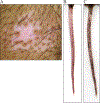Mouse Model for Human Vitiligo
- PMID: 30253067
- PMCID: PMC6340773
- DOI: 10.1002/cpim.63
Mouse Model for Human Vitiligo
Abstract
Vitiligo is an autoimmune skin disease in which the pigment-producing melanocytes are destroyed by autoreactive CD8+ T cells. As a result, patients develop disfiguring white spots on the skin. This article discusses the first mouse model of vitiligo that develops epidermal depigmentation, similar to disease in human patients. To achieve epidermal depigmentation, mice are genetically engineered to retain melanocytes in the skin epidermis. Induction of disease occurs by adoptive transfer of melanocyte-specific CD8+ T cells into recipient mice and the subsequent activation of these T cells using a viral vector. Depigmentation of the epidermis occurs within 5 to 7 weeks in a patchy pattern similar to patients with vitiligo. This article describes the methods of vitiligo induction, quantification of lesion progression and regression, processing of the skin for detailed analysis, and how to use this model to inform clinical studies. © 2018 by John Wiley & Sons, Inc.
Keywords: CD8 T cells; autoimmunity; melanocyte; mice; vitiligo.
© 2018 John Wiley & Sons, Inc.
Figures









Similar articles
-
A mouse model of vitiligo with focused epidermal depigmentation requires IFN-γ for autoreactive CD8⁺ T-cell accumulation in the skin.J Invest Dermatol. 2012 Jul;132(7):1869-76. doi: 10.1038/jid.2011.463. Epub 2012 Feb 2. J Invest Dermatol. 2012. PMID: 22297636 Free PMC article.
-
Melanocyte-specific CD8+ T cells are associated with epidermal depigmentation in a novel mouse model of vitiligo.Clin Exp Immunol. 2013 Oct;174(1):38-44. doi: 10.1111/cei.12146. Clin Exp Immunol. 2013. PMID: 23711243 Free PMC article.
-
The Role of Memory CD8+ T Cells in Vitiligo.J Immunol. 2019 Jul 1;203(1):11-19. doi: 10.4049/jimmunol.1900027. J Immunol. 2019. PMID: 31209143 Free PMC article. Review.
-
Simvastatin prevents and reverses depigmentation in a mouse model of vitiligo.J Invest Dermatol. 2015 Apr;135(4):1080-1088. doi: 10.1038/jid.2014.529. Epub 2014 Dec 18. J Invest Dermatol. 2015. PMID: 25521459 Free PMC article.
-
Initiation and regulation of CD8+T cells recognizing melanocytic antigens in the epidermis: implications for the pathophysiology of vitiligo.Eur J Cell Biol. 2004 Dec;83(11-12):797-803. doi: 10.1078/0171-9335-00423. Eur J Cell Biol. 2004. PMID: 15679123 Review.
Cited by
-
Type I interferon signaling limits viral vector priming of CD8+ T cells during initiation of vitiligo and melanoma immunotherapy.Pigment Cell Melanoma Res. 2021 Jul;34(4):683-695. doi: 10.1111/pcmr.12935. Epub 2020 Oct 26. Pigment Cell Melanoma Res. 2021. PMID: 33040466 Free PMC article.
-
Resident Memory and Recirculating Memory T Cells Cooperate to Maintain Disease in a Mouse Model of Vitiligo.J Invest Dermatol. 2019 Apr;139(4):769-778. doi: 10.1016/j.jid.2018.10.032. Epub 2018 Nov 10. J Invest Dermatol. 2019. PMID: 30423329 Free PMC article.
-
Plant-Derived Compounds as Promising Therapeutics for Vitiligo.Front Pharmacol. 2021 Nov 11;12:685116. doi: 10.3389/fphar.2021.685116. eCollection 2021. Front Pharmacol. 2021. PMID: 34858164 Free PMC article. Review.
-
Translational Research in Vitiligo.Front Immunol. 2021 Mar 2;12:624517. doi: 10.3389/fimmu.2021.624517. eCollection 2021. Front Immunol. 2021. PMID: 33737930 Free PMC article. Review.
-
3D-hUMSCs Exosomes Ameliorate Vitiligo by Simultaneously Potentiating Treg Cells-Mediated Immunosuppression and Suppressing Oxidative Stress-Induced Melanocyte Damage.Adv Sci (Weinh). 2024 Aug;11(31):e2404064. doi: 10.1002/advs.202404064. Epub 2024 Jun 17. Adv Sci (Weinh). 2024. PMID: 38887870 Free PMC article.
References
-
- Alkhateeb A, Fain PR, Thody A, Bennett DC, & Spritz RA (2003). Epidemiology of vitiligo and associated autoimmune diseases in Caucasian probands and their families. Pigment Cell Research, 16(3), 208–214. - PubMed
Publication types
MeSH terms
Substances
Grants and funding
LinkOut - more resources
Full Text Sources
Other Literature Sources
Medical
Research Materials

